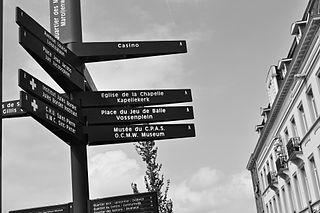
The term multiculturalism has a range of meanings within the contexts of sociology, political philosophy, and colloquial use. In sociology and in everyday usage, it is a synonym for "ethnic pluralism", with the two terms often used interchangeably, and for cultural pluralism in which various ethnic and cultural groups exist in a single society. It can describe a mixed ethnic community area where multiple cultural traditions exist or a single country within which they do. Groups associated with an indigenous, aboriginal or autochthonous ethnic group and settler-descended ethnic groups are often the focus.
The Royal Commission on Bilingualism and Biculturalism was a Canadian royal commission established on 19 July 1963, by the government of Prime Minister Lester B. Pearson to "inquire into and report upon the existing state of bilingualism and biculturalism in Canada and to recommend what steps should be taken to develop the Canadian Confederation on the basis of an equal partnership between the two founding races, taking into account the contribution made by the other ethnic groups to the cultural enrichment of Canada and the measures that should be taken to safeguard that contribution".
Cultural assimilation is the process in which a minority group or culture comes to resemble a society's majority group or assimilate the values, behaviors, and beliefs of another group whether fully or partially.

A multitude of languages have always been spoken in Canada. Prior to Confederation, the territories that would become Canada were home to over 70 distinct languages across 12 or so language families. Today, a majority of those indigenous languages are still spoken; however, most are endangered and only about 0.6% of the Canadian population report an Indigenous language as their mother tongue. Since the establishment of the Canadian state, English and French have been the co-official languages and are, by far, the most-spoken languages in the country.

William Kymlicka is a Canadian political philosopher best known for his work on multiculturalism and animal ethics. He is currently Professor of Philosophy and Canada Research Chair in Political Philosophy at Queen's University at Kingston, and Recurrent Visiting Professor in the Nationalism Studies program at the Central European University in Budapest, Hungary. For over 20 years, he has lived a vegan lifestyle, and he is married to the Canadian author and animal rights activist Sue Donaldson.

The official languages of Canada are English and French, which "have equality of status and equal rights and privileges as to their use in all institutions of the Parliament and Government of Canada," according to Canada's constitution. "Official bilingualism" is the term used in Canada to collectively describe the policies, constitutional provisions, and laws that ensure legal equality of English and French in the Parliament and courts of Canada, protect the linguistic rights of English- and French-speaking minorities in different provinces, and ensure a level of government services in both languages across Canada.
Jaroslav-Bohdan Antonovych Rudnyckyj was a Ukrainian-Canadian linguist and lexicographer with a specialty in etymology and onomastics, folklorist, bibliographer, travel writer, and publicist. He was one of the pioneers of Slavic Studies in Canada and one of the founding fathers of Canadian "Multiculturalism". In scholarship, he is best known for his incomplete two volume Etymological Dictionary of the Ukrainian Language (1962–82), his Ukrainian-German Dictionary (1943), and his extensive study of the term and name "Ukraine" (1951).

Language politics is the way language and linguistic differences between peoples are dealt with in the political arena. This could manifest as government recognition, as well as how language is treated in official capacities.
Bimodal bilingualism is an individual or community's bilingual competency in at least one oral language and at least one sign language, which utilize two different modalities. An oral language consists of a vocal-aural modality versus a signed language which consists of a visual-spatial modality. A substantial number of bimodal bilinguals are children of deaf adults (CODA) or other hearing people who learn sign language for various reasons. Deaf people as a group have their own sign language(s) and culture that is referred to as Deaf, but invariably live within a larger hearing culture with its own oral language. Thus, "most deaf people are bilingual to some extent in [an oral] language in some form" In discussions of multilingualism in the United States, bimodal bilingualism and bimodal bilinguals have often not been mentioned or even considered, in part because American Sign Language, the predominant sign language used in the U.S., only began to be acknowledged as a natural language in the 1960s. However, bimodal bilinguals share many of the same traits as traditional bilinguals, as well as differing in some interesting ways, due to the unique characteristics of the Deaf community. Bimodal bilinguals also experience similar neurological benefits as do unimodal bilinguals, with significantly increased grey matter in various brain areas and evidence of increased plasticity as well as neuroprotective advantages that can help slow or even prevent the onset of age-related cognitive diseases, such as Alzheimer's and dementia.
Bilingual–Bicultural or Bi-Bi deaf education programs use sign language as the native, or first, language of Deaf children. In the United States, for example, Bi-Bi proponents state that American Sign Language (ASL) should be the natural first language for deaf children in the United States, although the majority of deaf and hard of hearing being born to hearing parents. In this same vein, the spoken or written language used by the majority of the population is viewed as a secondary language to be acquired either after or at the same time as the native language.

Canadian identity refers to the unique culture, characteristics and condition of being Canadian, as well as the many symbols and expressions that set Canada and Canadians apart from other peoples and cultures of the world. Primary influences on the Canadian identity trace back to the arrival, beginning in the early seventeenth century, of French settlers in Acadia and the St. Lawrence River Valley, and of English, Scottish and Irish settlers in Newfoundland and the Maritimes, the British conquest of New France in 1759, the migration of United Empire Loyalists to Upper Canada and New Brunswick, and the ensuing dominance of French and British culture in the gradual development of both an imperial and national identity.
World Englishes is a term for emerging localised or indigenised varieties of English, especially varieties that have developed in territories influenced by the United Kingdom or the United States. The study of World Englishes consists of identifying varieties of English used in diverse sociolinguistic contexts globally and analyzing how sociolinguistic histories, multicultural backgrounds and contexts of function influence the use of English in different regions of the world.
Linguistic discrimination is unfair treatment of people which is based on their use of language and the characteristics of their speech, including their first language, their accent, the perceived size of their vocabulary, their modality, and their syntax. For example, an Occitan speaker in France will probably be treated differently from a French speaker. Based on a difference in use of language, a person may automatically form judgments about another person's wealth, education, social status, character or other traits, which may lead to discrimination.

Deaf education is the education of students with any degree of hearing loss or deafness. This may involve, but does not always, individually-planned, systematically-monitored teaching methods, adaptive materials, accessible settings, and other interventions designed to help students achieve a higher level of self-sufficiency and success in the school and community than they would achieve with a typical classroom education. There are different language modalities used in educational setting where students get varied communication methods. A number of countries focus on training teachers to teach deaf students with a variety of approaches and have organizations to aid deaf students.

Canadians are people identified with the country of Canada. This connection may be residential, legal, historical or cultural. For most Canadians, many of these connections exist and are collectively the source of their being Canadian.

Multiculturalism in Canada was officially adopted by the government during the 1970s and 1980s. The Canadian federal government has been described as the instigator of multiculturalism as an ideology because of its public emphasis on the social importance of immigration. The 1960s Royal Commission on Bilingualism and Biculturalism is often referred to as the origin of modern political awareness of multiculturalism, resulting in Canada being one of the most multicultural nations in the world. The official state policy of multiculturalism is often cited as one of Canada's significant accomplishments, and a key distinguishing element of Canadian identity and Canadian values.
Intercultural bilingual education(Educación bilingüe intercultural) is a language-planning model employed throughout Latin America in public education, and it arose as a political movement asserting space for indigenous languages and culture in the education system. IBE is designed to address the educational needs of indigenous communities, and consists of various bilingual curriculum designs.
Bicultural identity is the condition of being oneself regarding the combination of two cultures. The term can also be defined as biculturalism, which is the presence of two different cultures in the same country or region. As a general term, culture involves the behaviors and belief characteristics of a particular social, ethnic, or age group. Within culture, we have cultural effects, which are the shared behaviors and customs we learn from the institutions around us. An example of a cultural effect would be how an individual's personality is strongly influenced by the biological and social norms he is exposed to. Another cultural effect would be that in some societies it would be more acceptable to dress or act in a certain way.

Feminism in New Zealand is a series of actions and a philosophy to advance rights for women in New Zealand. This can be seen to have taken place through parliament and legislation, and also by actions and role modelling by significant women and groups of people throughout New Zealand's history. The women's suffrage movement in New Zealand succeeded in 1893 when New Zealand became the first nation where all women were awarded the right to vote. New Zealand was also the first country in the world in which the five highest offices of power were held by women, which occurred between March 2005 and August 2006, with Queen Elizabeth II, Governor-General Silvia Cartwright, Prime Minister Helen Clark, Speaker of the New Zealand House of Representatives Margaret Wilson and Chief Justice Sian Elias.







